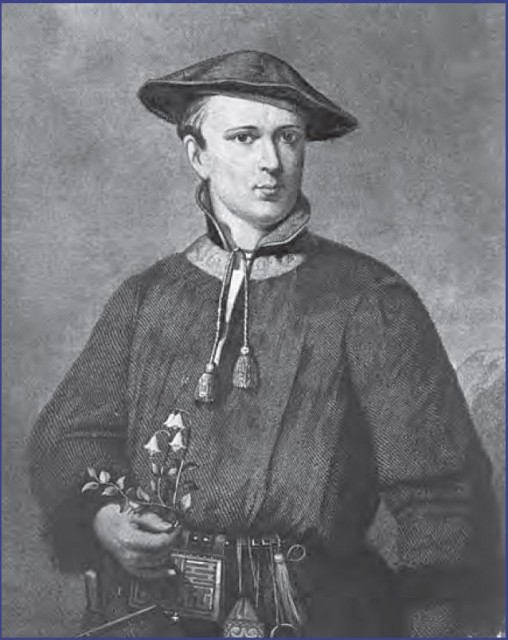Carolus Linnaeus and the Binomial System
A common plant is likely to have many names, but to avoid confusion it will have only one scientific name. The scientific name will be in Latin and it will have two parts, the first being the name of the genus and the second of the species. This use of two names to identify a species is called the binomial system. Caspar Bauhin and his brother Jean, working in the late 16th century, were the first botanists to use the binomial system, but the scientist who developed it and set it within a broader taxonomic concept was the Swedish botanist Carolus Linnaeus (1707–78).
In 1735 Linnaeus published the first edition of Systema naturae per regna tria naturae, secundum classes, ordines, genera, species, cum characteribus, differentiis, synonymis, locis (System of nature through the three kingdoms of nature, according to classes, orders, genera, species, with characters, differences, synonyms, places), the book describing his taxonomic system. It had only 11 pages, but by the time Systema naturae reached its 13th and final edition, published in 1770, it had grown to about 3,000 pages and listed 4,400 species of animals and 7,700 species of plants. In 1737 Linnaeus published his book Genera plantarum (Plant genera) and in 1753 he published Species plantarum (Plant species).
In Species plantarum Linnaeus described every species of plant known at the time and arranged the species within the taxonomic scheme he had devised. These two works are to this day the scientific starting point for the classification of all flowering plants and ferns. Linnaeus brought together the botanical material in Systema naturae with the material in Genera plantarum and Species plantarum in his 1779 work Systema plantarum (Botanical system). In total Linnaeus wrote about 180 books.

Carl Linnaeus was born on May 23, 1707, on a farm at Rashult, in Smaland, southern Sweden. Linnaeus wrote in Latin, and Carolus is the Latin version of his name, which he used in his professional life. His father, Nils Ingemarsson Linnaeus, was a clergyman who, as was the custom at the time in Smaland, had originally been known by his patronymic name: Ingemarsson means son of Ingemar. But when Nils enrolled at university, the authorities needed to know his surname, so he gave himself the name Linnaeus, after an old and much-loved lime tree (linn in the Smaland dialect) on land the family owned. Nils was a keen gardener and familiar with the wild flowers growing in the area, and by the time Carl was four his father was teaching him about plants and encouraging him to learn their names. Carl's passion for naming plants came to shape his adult life.
Linnaeus began his education with a tutor and then attended a school in the nearby town of Vaxjo before entering the University of Lund in 1727 to study medicine. The following year he transferred to the University of Uppsala, where there was a botanical garden in which he spent as much time as he could. Linnaeus became friendly with Olof Celsius (1701–44), the dean of Uppsala Cathedral, and Celsius, recognizing the young man's enthusiasm for plants, introduced him to Olof Rudbeck (1660–1740), the garden's director. Rudbeck was approaching retirement and he invited Linnaeus—a first-year student—to deliver botany lectures. It was at about this time that Linnaeus began to feel his way toward devising a system for classifying plants on the basis of their flower structure along the lines Tournefort had pioneered.
In 1732 Linnaeus spent four months exploring Lapland, then a vast wilderness extending across northern Sweden, Finland, and Russia. He walked to the shore of the Arctic Ocean, collecting plants all the way. The following year Linnaeus became engaged to Sara Elisabeth Moraeus, the daughter of Johan Moraeus, a physician who advised him to complete his medical studies in the Netherlands. Linnaeus did so, qualifying in 1735 at the University of Harderwijk, after which he spent a short time in England before returning to the Netherlands. His meeting later that year with George Clifford led to Linnaeus compiling the Hortus Cliffortianus, a book describing Clifford's plant collection. Linnaeus began practicing medicine in Stockholm in 1738. His practice was successful and allowed him time to continue his botanical studies. He was a founding member of the Royal Swedish Academy of Sciences in 1739. He was appointed professor of medicine at the University of Uppsala in 1741, but within a year he exchanged that post to become professor of botany. King Adolf Fredrik made Linnaeus a Knight of the Polar Star in 1758 and the Privy Council confirmed his ennoblement in 1761. From that time Linnaeus took the name Carl von Linne.
Von Linne's health began to fail in 1772, and in 1774 he suffered a stroke from which he made a partial recovery. The illustration on page 83, from an engraving made in 1775, shows him in his early 30s, wearing Lapp dress. A second stroke in 1776 paralyzed his right side. He died on January 22, 1778, during a ceremony in Uppsala Cathedral, where he is buried.
- Joseph Pitton de Tournefort and the Grouping of Plants
- Jose Mutis and the Bogota Botanical Garden
- Jean-Baptiste Lamarck and the Royal Garden, Paris
- Sir William Hooker, the First Official Director
- Sir Joseph Banks, Unofficial Director of Kew
- Sir Henry Capel, Princess Augusta, and the Royal Botanic Gardens at Kew
- Tulipomania
- Carolus Clusius, the Leiden Botanical Garden, and the Tulip
- Pisa, Padua, and Florence, the First Botanical Gardens